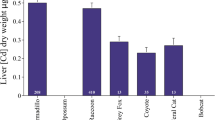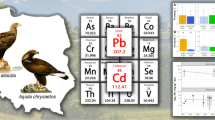Abstract
This study presents concentrations of heavy metals (manganese, zinc, lead, and cadmium) in tissues in six orders of Korean wild birds (n = 37), 2000–2002. Zinc, manganese, lead, and cadmium concentrations in all tissues were highest in ancient murrelets (Synthliboramphus antiquus). Essential elements in Korean wild birds were within the normal range for wild birds and are maintained there by a normal homeostatic mechanism. Lead concentrations in livers of almost all birds were within the background levels. Cadmium concentrations in livers and kidneys of ancient murrelets exceeded background levels for wild birds, but other birds were within the normal range. Acute and chronic contaminations of lead and cadmium levels differed among groups (or species). We suggest that differences in lead and cadmium concentrations among groups are because of differences in diet and habitat. In ancient murrelets, zinc and manganese concentrations correlated with their cadmium concentration in livers. Zinc, manganese, and cadmium concentrations in murrelet livers were also higher than in other species. Therefore, we suggest that high zinc and manganese concentrations in ancient murrelets were related to their high cadmium concentrations.


Similar content being viewed by others
References
Battaglia A, Ghidini S, Campanini G, Spaggiari R (2005) Heavy metal contamination in little owl (Athene noctuna) and common buzzard (Buteo buteo) from Northern Italy. Ecotoxicol Environ Safety 60:61–66 (doi: 10.1016/j.ecoenv.2003.12.019)
Buerger TT, Mirachi RE, Lisano ME (1986) Effects of lead shot ingestion of captive mourning dove survivability and reproduction. J Wildlife Manage 50:1–8 (doi: 10.2307/3801479)
Bull KR, Murton RK, Osborn D, Ward P, Cheng G (1977) High cadmium levels in Atlantic sea birds and seaskaters. Nature 269:507–509 (doi: 10.1038/269507a0)
Bull KR, Every WJ, Freestone P, Hall JR, Osborn D, Cooke AS, Stowe T (1983) Alkyl lead pollution and bird mortalities on the Mersey Estuary, UK, 1979–1981. Environ Pollut (Series A) 31:239–259 (doi: 10.1016/0143-1471(83)90062-4)
Cheney MA, Hacker CS, Schroder GD (1981) Bioaccumulation of lead and cadmium in the Lousiana heron Hydranassa tricolor and the cattle egret Bubulcus ibis. Ecotoxicol Environ Safe 5:211–224 (doi: 10.1016/0147-6513(81)90036-1)
Clark AJ, Scheuhammer AM (2003) Lead poisoning in upland-foraging birds of prey in Canada. Ecotoxicology 12:23–30 (doi: 10.1023/A:1022576510445)
Cosson RP, Amiard J, Amiard-Triquet C (1988) Trace elements in little egrets and flamingos of Camargue, France. Ecotoxicol Environ Safe 15:107–116 (doi: 10.1016/0147-6513(88)90047-4)
Custer CM, Custer TW, Michael JA, Alan DA, David EW (2003) Trace elements in Lesser Scaup (Aythya affinis) from the Mississippi Flyway. Ecotoxicology 12:47–54
Custer TW, Franson JC, Pattee OH (1984) Tissue lead distribution and hematologic effects in American kestrels (Falco sparverius) fed biologically incorporated lead. J Wildl Dis 20:39–43
Custer TW, Pendleton G, Ohlendorf HM (1990) Within-clutch and among clutch variation of organochlorines residues in eggs of black-crowned night herons. Environ Monitor Assess 15:83–90 (doi: 10.1007/BF00454750)
Custer TW, Custer CM, Eichhorst BA, David W (2007) Selenium and metal concentrations in waterbird eggs and chicks at Agassiz National Wildlife Refuge, Minnesota. Arch Environ Contam Toxicol 53:103–109 (doi: 10.1007/s00244-006-0139-7)
Dauwe T, Janssens E, Kempenaers B, Eens M (2004) The effect of heavy metal exposure on egg size, eggshell thickness and the number of spermatozoa in blue tit Parus caerulens eggs. Environ Pollut 129:125–129 (doi: 10.1016/j.envpol.2003.09.028)
Elliott JE, Scheuhammer AM (1997) Heavy metal and metallothionein concentrations in seabirds from the pacific coast of Canada. Mar Pollut Bull 34:794–801 (doi: 10.1016/S0025-326X(97)00034-9)
Elliott JE, Scheuhammer AM, Leighton FA, Pearce PA (1992) Heavy metals and metallothionein concentrations in Atlantic Canadian seabirds. Arch Environ Contam Toxicol 22:63–73 (doi: 10.1007/BF00213303)
Esselink H, Van der Geld FM, Jager LP, Posthuma-Trumpie GA, Zoun PEF, Baars AJ (1995) Biomonitoring heavy metals using the barn owl (Tyto alba guttata): sources of variation especially relating to body condition. Arch Environ Contam Toxicol 28:471–486 (doi: 10.1007/BF00211630)
Furness RW (1996) Cadmium in birds. In: Beyer WN, Heinz GH, Redmon-Norwood AW (eds) Environmental contaminants in wildlife. CRC Press, Boca Raton, FL, pp 389–404
Furness RW, Greenwood JJD (1993) Birds as monitors of environmental change. Chapman & Hall, London, pp 102–120
Gasaway WC, Buss IO (1972) Zinc toxicity in the mallad duck. J Wildlife Manage 36:1107–1117 (doi: 10.2307/3799239)
Goyer RA (1995) Nutrition and metal toxicity. Am Clin Nutr 61(Supp l):646–650
Honda K, Min BY, Tatsukawa R (1986) Organ and tissue distribution of heavy metals, and age-related changes in the eastern great white egret Egretta alba modesta in the Korea. Arch Environ Contam Toxicol 15:185–197 (doi: 10.1007/BF01059967)
Honda K, Marcovecchio JE, Kan S, Tatsukawa R, Ogi H (1990) Metal concentrations in pelagic seabirds from the north Pacific ocean. Arch Environ Contam Toxicol 19:704–711 (doi: 10.1007/BF01183988)
Hontelez LCMP, Dungen HM, Baars AJ (1992) Lead and cadmium in birds in the Netherlands: a preliminary survey. Arch Environ Contam Toxicol 23:453–456 (doi: 10.1007/BF00203808)
Hulse M, Mahoney JS, Schroder GD, Hacker CS, Pier SM (1980) Environmentally acquired lead, cadmium and manganese in the cattle egret Bubulcus ibis and laughing gull Larus articilla. Arch Environ Contam Toxicol 9:65–78 (Medline. doi: 10.1007/BF01055500)
Hutton M, Goodman GT (1980) Metal contamination of feral pigeons Columbia livia from the London area–Part I. Tissue accumulation of lead, cadmium, and zinc. Environ Pollut 22:207–217 (doi: 10.1016/0143-1471(80)90015-X)
Jager LP, Rijnierse FVJ, Esselink H, Baars AJ (1996) Biomonitoring with the buzzard Buteo buteo in the Netherlands: heavy metals and sources of variation. J Ornithol 137:295–318 (doi: 10.1007/BF01651071)
Janssens DL, Dauwe T, Pinxten R, Bervoets L, Blust R, Eens M (2003) Effects of heavy metal exposure on the condition and health of nestling of the great tit (Parus major), a small songbirds species. Environ Pollut 126:267–274 (doi: 10.1016/S0269-7491(03)00185-4)
Jeong M-S (1998) Ecology and conservation of rural forest birds in the highway construction region. Dr. thesis. Kyung Hee University, Korea
Kim E-Y, Goto R, Tanabe S, Tanaka H, Tatsukawa R (1998) Distribution of 14 elements in tissues and organs of oceanic seabirds. Arch Environ Contam Toxicol 35:638–645 (doi: 10.1007/s002449900426)
Kim E-Y, Ichihashi H, Saeki K, Atrashkevich G, Tanabe S, Tatsukawa R (1996) Metal accumulation in tissues of seabirds from Chaun, northeast Siberia, Russia. Environ Pollut 92:247–252 (doi: 10.1016/0269-7491(96)00007-3)
Kim J, Koo T-H (2007a) Heavy metal concentrations in diet and livers of Black-crowned night heron Nycticorax nycticorax and grey heron Ardea cinerea chicks from Pyeongtaek, Korea. Ecotoxicology 16:411–416 (doi: 10.1007/s10646-007-0143-3)
Kim J, Koo T-H (2007b) The use of feathers to monitor heavy metal contamination in herons, Korea. Arch Environ Contam Toxicol. 53:411–441 (doi: 10.1007/s00244-006-0196-y)
Kim J, Koo T-H (2008) Heavy metal distribution in chicks of two heron species from Korea. Arch Environ Contam Toxicol 54:740–747
Kim J, Park S-K, Koo T-H (2007) Trace elements and pollutants concentrations in shorebirds from Yeongjong Island, Korea in the East Asian-Australian migration flyways. Ecotoxicology 16:403–410 (doi: 10.1007/s10646-007-0141-5)
Kim J, Lee H, Koo T-H (2008) Heavy-metal concentrations in three owl species from Korea. Ecotoxicology 17:21–28 (doi: 10.1007/s10646-007-0172-y)
Kim S-J, Lee J-N, Lee D-P (2006) Cadmium and lead levels of loons wintering in Korea. J Ecol Field Biol 29:539–543 (in Korean)
Lee D-P (2004) Heavy metal accumulation in some Korean rare bird species. J Ecol Field Biol 27:141–146 (in Korean)
Lee D-P, Honda K, Tatsukawa R (1987) Comparison of tissue distribution of heavy metals in birds in Japan and Korea. J Yamashina Inst Ornithol 19:103–116 (in Japanese)
Martin MB, Reiter R, Pham T, Avellanet YR, Camara J, Lahm M, Pentecost E, Pratap K, Gilmore BA, Divekar S, Dagata RS, Bull JL, Stoica A (2003) Estrogen-like activity of metals in Mcf-7 breast cancer cells. Endocrinology 144:2425–2436
Mateo R, Taggart M, Meharg AA (2003) Lead and arsenic in bones of birds of prey from Spain. Environ Pollut 126:107–114 (doi: 10.1016/S0269-7491(03)00055-1)
Muirhead SJ, Furness RW (1988) Heavy metal concentrations in the tissues of seabird from Gough Island, South Atlantic Ocean. Mar Pollut Bull 19:278–283 (doi: 10.1016/0025-326X(88)90599-1)
Nam D-H, Lee D-P (2006) Reproductive effects of heavy metal accumulation on breeding feral pigeons (Columba livia). Sci Tot Environ 366:682–687 (doi: 10.1016/j.scitotenv.2006.02.004)
Nordberg GF (1971) Effects of acute and chronic cadmium exposure on the testicles of mice. Environ Physiol 1:171–187
NRC (National Research Council) (1991) Animals and sentinels of environmental health hazards. National Academic Press, Washington, DC
Rattner BA, Hoffman DJ, Melancon MJ, Olsen GH, Schmidt SR, Parsons KC (2000) Organochlorine and metal contaminant exposure and effects in hatching black-crowned night herons (Nycticorax nycticorax) in Delaware Bay. Arch Environ Contam Toxicol 39:38–45 (doi: 10.1007/s002440010077)
Rodgers JA Jr (1997) Pesticide and heavy metal levels of waterbirds in the Everglades agricultural area of south Florida. Fla Field Nat 25:33–41
Scheuhammer AM (1987) The chronic toxicity aluminium, cadmium, mercury and lead in birds: a review. Environ Pollut 46:263–295 (doi: 10.1016/0269-7491(87)90173-4)
Sorensen EM (1991) Metal poisoning in fish. CRC Press, Boca Raton, FL
Stewart FM, Thompson DR, Furness RW, Harrison N (1994) Seasonal variation in heavy metal levels in tissues of common guillemots, Uria aalge from northwest Scotland. Arch Environ Contam Toxicol 27:68–175 (doi: 10.1007/BF00214259)
Stoica A, Katzenellenbogen BS, Martin MB (2000) Activation of estrogen receptor-α by the heavy metal cadmium. Mol Endocrinol 14:545–553 (doi: 10.1210/me.14.4.545)
Takekawa JY, Wainwright-De La Cruz SE, Hothem RL, Yee J (2002) Relating body condition to inorganic contaminant concentrations of diving ducks wintering in coastal California. Arch Environ Contam Toxicol 42:60–70 (doi: 10.1007/s002440010292)
Underwood EJ (1971) Trace element in human and animal nutrition, 3rd edn. Academic Press, New York
Acknowledgments
Ancient murrelets samples were provided by Jong-Gil Park (National Park Migratory Birds Center, Korea) and thanks to J.-G. Park and NPMBC. We are grateful to Thomas W. Custer (USGS) for his critical reading of the manuscript and comments.
Author information
Authors and Affiliations
Corresponding author
Rights and permissions
About this article
Cite this article
Kim, J., Shin, JR. & Koo, TH. Heavy Metal Distribution in Some Wild Birds from Korea. Arch Environ Contam Toxicol 56, 317–324 (2009). https://doi.org/10.1007/s00244-008-9180-z
Received:
Accepted:
Published:
Issue Date:
DOI: https://doi.org/10.1007/s00244-008-9180-z




